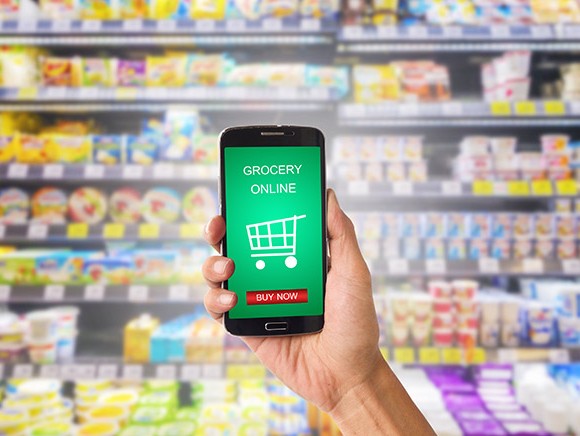
Online grocery shopping still hasn’t really caught on among Dutch consumers. Although the online share of food sales rose slightly to 2.1% in 2016 compared with 1.2% in 2015, that percentage is still low in comparison with other sectors (such as household goods and clothing). “Offline is still the major player right now,” says Jean-Marc Dagevos. “The regular trips to the supermarket are still a deeply ingrained ritual that consumers find it hard to let go of. Their ‘system’ hasn’t yet adjusted to the idea of buying groceries online – even though, on an annual basis, trips to the supermarket take up more of our time than any other form of shopping.”
So according to Dagevos, e-commerce hasn’t (yet) disrupted the grocery sector, although he is quick to add that “it won’t be long now until it does”. Several recent developments have set the food industry on high alert. For example, Amazon put the cat among the pigeons by acquiring US food retailer Whole Foods. In the longer term that will lead to increased competition in the Dutch grocery market, predicts Dagevos. Another example is the rise of meal kits, which are having a clear impact on the online food market. Various Dutch supermarket chains have now started offering a meal-kit service of their own or are in the process of developing one. Furthermore, Dagevos mentions the arrival of Picnic – an online supermarket offering a limited product range that competes mainly on price – and the launch of the Beerwulf website is being watched with interest in the food sector. Beerwulf is an online marketplace giving (small) brewers of craft beers access to potential customers. It’s a smart concept according to Dagevos: “The people behind this start-up are linking the home-brewing trend to the growing demand for craft beers. They are capitalising on what’s going on in the market while simultaneously building up a database of customer profiles.”
4FOOD Software
4FOOD Software has been developing and building software for food companies for more than ten years. The firm offers both back-office and e-commerce solutions. For example, 4FOOD Software recently launched the 4FOOD Software program that offers smart applications for logistics automation (ERP), big data, labelling and webshops.
The above-mentioned developments show that the food sector is on the verge of digitisation. Research firm GfK forecasts that 6% of food will be sold online by 2020. Dagevos sees plenty of opportunities for food manufacturers and wholesalers; the internet makes it possible for them to supply direct to consumers rather than via retailers, although it requires a different mindset. Dagevos: “Many traditional food companies still think in terms of shipping full truck loads and containers – those kinds of volumes. But consumers are an interesting target group too. That’s a missed opportunity so far.” According to Dagevos, one of the categories best positioned to benefit from that is ‘specialist delivery’ (suppliers of a single type of product or product group): “This category has a higher online conversion rate than general grocery. The main reason is the high level of consumer goodwill, created through things like a local identity, branding or authenticity.” In addition to a new mindset, another prerequisite for strong online sales is suitable technology – and that often leaves a lot to be desired, says Dagevos. For example, suppliers sometimes cannot comply with their customers’ requirements: “A company like Picnic asks manufacturers and wholesalers to provide details of their product range in the right digital feed, but they can’t.” He goes on to give more examples of digitisation hiccups: “Many company websites are designed for order entry rather than e-commerce. Companies are failing to invest enough in making it easy to order, and their online catalogues are below par. Plus we’re still seeing too many Excel sheets, in the ordering process, production planning and quality registration alike. This not only creates inefficiency due to the duplication of work, but companies also get bogged down in their own processes. That leaves us itching to get involved.”

As he sees it, time is running out for companies who don’t yet have their logistics and/or e-commerce on the right track: “The food sector is digitising and there’s no turning back. My advice would be to analyse which of your company activities can be done digitally. Make it easy for consumers to buy food online, explore how you can become part of their regular grocery shopping ritual, and ensure that you have good online data and a good online catalogue.” Despite the fact that food companies have a lot of catching up to do, he believes they have a bright digital future ahead of them: “Many companies are well aware that they’ve got a lot of work to do in online if they don’t want to miss the boat.”
Photo: Jean-Marc Dagevos
Source: Foto mobiel; ©non c/Shutterstock.com